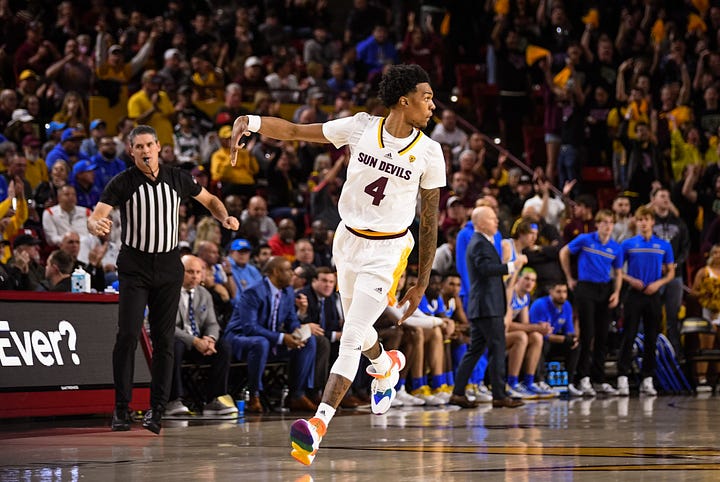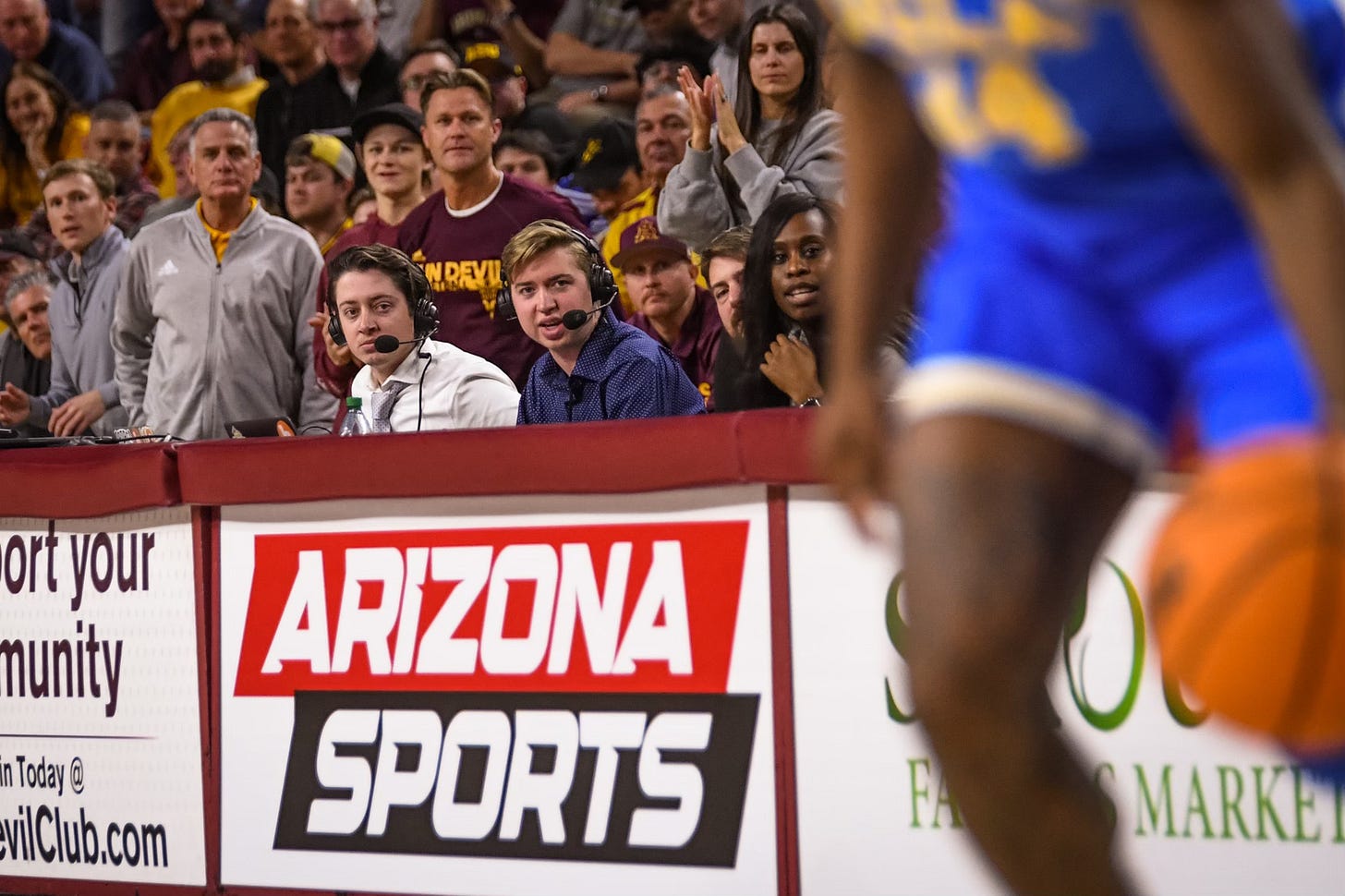Canzano: FS1 remote broadcast rankles Pac-12
Part 1 of a series on Pac-12 basketball.
TEMPE, Ariz. — There was electricity in the building on Thursday night. UCLA and Arizona State were warming up for a high-profile men’s basketball game — arguably the biggest one yet in the Pac-12 Conference regular season.
The rafters of Desert Financial Arena rumbled. Sun Devil students showed up in record numbers. ASU coach Bobby Hurley would later say he looked around the arena before the game and got “goosebumps.” In the run-up to tip-off, 14,000 ticket holders poured through the arena doors.
There were only two empty seats in the house.
The best ones, it turns out.
“When I saw they weren’t coming on an email, I was bummed,” said Doug Tammaro, ASU’s senior associate athletic director. “You’re just bummed out.”
Those two empty seats — near center court at the scorer’s table — are typically reserved for the game’s on-air television broadcast crew. But on Thursday night, FS1 play-by-play broadcaster Aaron Goldsmith and analyst Casey Jacobsen weren’t in Tempe. They called the game remotely.
Tammaro filled those prime media seats instead with two members of ASU’s campus radio crew. The student broadcasters normally sit in the last row of the press tribune and call the game. Good for them on the upgrade, but is any of this positive for live sports programming? Does it suggest anything about the Pac-12’s ongoing relationship with Fox? And how frequently is it happening?
This is Part 1 in an ongoing series about Pac-12 Conference basketball. The television broadcasts are one of the primary conduits between the schools and the public. They not only provide a vital source of revenue, but layers of branding and marketing, too.
The Pac-12 isn’t happy that FOX’s broadcast team wasn’t on site Thursday night to see the No. 5 Bruins face second-place Arizona State. A source said the Pac-12 was “disappointed” and the conference let FOX know this at the highest levels.
Observers noted during the broadcast that Goldsmith and Jacobsen made comments on-air such as “from where we’re at” and talked about the “energy in the building.” Muscle memory is hard to overcome, I suppose. But the broadcasters were nowhere near the ASU-UCLA game on Thursday night.
“We all understood the need to be remote during Covid,” Tammaro said. “I’ll be honest, we all got it. But I don’t see how that energy, that environment could be captured by someone in a studio far away.
“Human beings needed to be in the building.”
•••




FOX Sports has a business to run. Amid cord cutting and regional sports networks teetering on bankruptcy, the network is under increasing pressure to reduce expenses.
FOX did not respond to multiple requests for comment on this piece. But one network insider told me that there’s an internal push to save money in a way that doesn’t “materially affect the broadcast.”
At the center of it: Brad Zager.
The executive who was once dubbed the “Doogie Howser” of sports production by The Los Angeles Daily News was promoted to president of operations for FOX Sports in late 2021. Zager has decades of experience in event production and FOX employees speak favorably about his leadership.
Zager pushed for a massive investment in remote-production technology, a dozen new production trucks, and new studios in Los Angeles designed specifically for remote broadcasting.
“We’ve gone all-in on the remote front,” said one FOX production staff member. “Truth is, we’ve streamlined it. We don’t have a lot of broadcasters on the payroll and they don’t want a lot of broadcasters on the payroll.
“The investment is all in the technology.”
Industry experts will tell you that remote sports broadcasts have been going on for far longer than the public knows in a variety of college and professional events. Also, that being off site reduces the toll of travel for employees with families. It also allows broadcasters to call two games in the same day (or even pull off what would be an impossible Friday-Saturday two-game combination) during the college football season.
Some of the FOX analysts and play-by-play broadcasters call the games from the new FOX studios in Los Angeles. A few others with special arrangements work from home studios. Goldsmith, who was on the broadcast call for the UCLA-ASU game, has a studio at his home in Seattle but occasionally flies to Los Angeles to call a game.
“It’s a misnomer that we’re the only network that does this,” said a FOX production team member.
A second network source echoed: “ESPN broadcasts often feature announcers in the booth with a backdrop behind them instead of the traditional look with their backs to the field.
“When it’s remote, no one can tell.”
Can you tell?
•••

Mick Cronin’s team was on the ropes on Thursday night. UCLA was challenged by Arizona State’s interior length during the first half. The Sun Devils used a great defensive effort to carry a five-point lead in the break.
The FOX broadcast crew of Goldsmith and Jacobsen did its best to describe the action down the stretch. The Bruins ultimately imposed their will — going on a 9-0 run to finish the game and holding ASU scoreless in the final three minutes.
With 2:34 left and UCLA holding a three-point lead, Jaime Jaquez Jr. dribbled to the top of the arc and hit a three-point shot that broke the Sun Devils backs.
“He gets it,” Goldsmith said on the FS1 broadcast.
It was a back-breaking shot. Jaquez scored only nine points in the game. But his big bucket and the ensuing call of it was underscored by a larger question. Not only for the Pac-12, which is currently negotiating a new media rights agreement. But for the sports-media industry itself.
How far off are we from all broadcasts being remote?
The Pac-12 Networks currently broadcasts all of its basketball and football games with in-person crews. The conference’s frustration with FS1’s remote broadcasts reared its head during last college football season and is now apparent in basketball season.
Before Thursday’s game, ASU trailed UCLA by one game in the Pac-12 men’s basketball standings. Sun Devils’ coach Bobby Hurley had his team on a four-game conference winning streak. The Bruins stopped it cold with a 74-62 victory.
Said Hurley after the game: “It’s not a Disney movie and stuff, a fairy tale. One game behind. You get this great crowd. This is our moment. That’s not what life is about. You wish it was. But it’s not. They took it. They won it. All the credit to UCLA.”
Hurley did not conduct an in-person television interview with the FS1 crew after the game. Nor did Cronin, who met with reporters down the hallway, outside the Bruins’ locker room. Both head coaches visited with the FS1 broadcasters via Zoom video conference, however, before the game.
Tammaro, ASU’s associate AD, told me that FS1 requested 18 media credentials for Thursday’s event. He lamented that the network still had to hire staff to lay wire, operate cameras, and produce the event.
Why not send the broadcasters, too?
“I don’t know how much money they save,” Tammaro said. “But I think we’re getting too comfortable with it. We’re losing something when they’re not in the house, especially for a game like that.”
The Pac-12 complained to the highest levels of FOX about the remote broadcast. Arizona State wasn’t happy that FS1 didn’t care to show up. Tammaro stuck two giddy student-radio broadcasters — Dominic Stearn and Cavan Malayter — in the seats that Goldsmith and Jacobsen would have called the game from.
They had the time of their lives.
I appreciate all who read, support, subscribe and share this new, independent, endeavor with friends and families. If you’re not already a “paid” subscriber, please consider a subscription or a gift subscription for someone else:




I may be in the minority here, but to me the primary value of announcers is less about narrating the event and more about providing insight on the things we aren't able to see on our screen. If the only view and sounds of the event announcers have is the exact same thing we get at home, then announcers' presence loses value to the point that they almost detract more from the event than add to it.
If FOX is all about cutting costs - and I can't imagine the cost of a couple plane tickets and a night in a hotel amounts to much in the grand scheme - then just do away with announcers altogether and pipe in the public address feed.
I would think if the conference is that unhappy about this, now would be the perfect time to address it with media rights in negotiation.
The kids had a great time!
Bully for the kids. Off-site broadcasting and streaming will become the norm. One has to wonder with the cord-cutting going on as JC so well noted, whether FOX/ESPN will have the money to pay their respective various contracts already in place. I expect more terminations at both ESPN and FOX.
For youngsters out there, the norm back in the day when live sports were first broadcast on black and white TV on ABC, CBS, and NBC (the 3 available channels at the time that all shut down at midnight) you had one announcer on site in the booth. No color commentator in the booth or on the field.
The typical comment between plays in a football game: 'Bears, 3rd down and 6 to go." That was it.
No replay, and no review of any play calls. No sideline interviews or post-game interviews.
Growing up in Boston, we learned the results of the college games that were played west of the Mississippi on Saturday in the newspaper on Monday morning.
Back to the future?